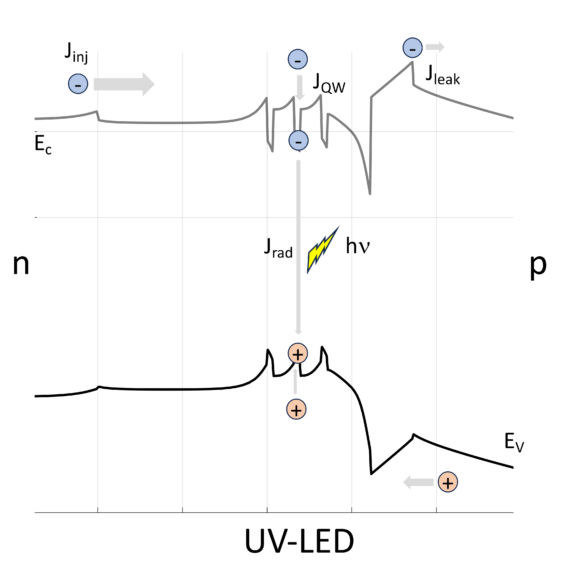Light emitting diodes (LEDs) provide an efficient way to convert electrical to optical power. Aluminum gallium nitride (AlGaN) LEDs produce ultraviolet (UV) radiation and will improve environmental, medical and industrial application with their compactness and efficiency. Those applications include curing, sterilization and water purification. Still, the quantum efficiency of UV-LEDs is lower than 10%, which is well below the efficiency of visible LEDs.
In this paper, Bernd Witzigmann and his team analyze the efficiency budget of a UV LED. By detailed comparison of theory and experiment, they find that the maximum carrier injection efficiency (CIE) is only 50% and decreases steeply both at low and at high currents. Besides light extraction efficiency, CIE is therefore the main factor limiting the electro-optical efficiency. The paper explains in detail the underlying mechanisms and proposes routes towards overcoming this limit.
For more information, see their publication in IEEE Photonics Journal:
Simulation of Carrier Injection Efficiency in AlGaN-Based UV-Light-Emitting Diodes
G. Hofmann et al.
IEEE Photonics Journal 16(4), 1-7 (2024)

Light emitting diodes (LEDs) provide an efficient way to convert electrical to optical power. Aluminum gallium nitride (AlGaN) LEDs produce ultraviolet (UV) radiation and will improve environmental, medical and industrial application with their compactness and efficiency. Those applications include curing, sterilization and water purification. Still, the quantum efficiency of UV-LEDs is lower than 10%, which is well below the efficiency of visible LEDs.
In this paper, Bernd Witzigmann and his team analyze the efficiency budget of a UV LED. By detailed comparison of theory and experiment, they find that the maximum carrier injection efficiency (CIE) is only 50% and decreases steeply both at low and at high currents. Besides light extraction efficiency, CIE is therefore the main factor limiting the electro-optical efficiency. The paper explains in detail the underlying mechanisms and proposes routes towards overcoming this limit.
For more information, see their publication in IEEE Photonics Journal:
Simulation of Carrier Injection Efficiency in AlGaN-Based UV-Light-Emitting Diodes
G. Hofmann et al.
IEEE Photonics Journal 16(4), 1-7 (2024)